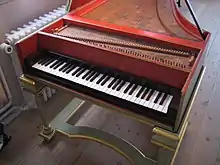Moritz Georg Moshack
Moritz Georg Moshack (1730 – before 1772) was a builder of Danish clavichords.[1] Three of his instruments are known to exist: a fret-free clavichord dating to 1768 at the Norsk Folkemuseum, Oslo, Norway;[2] a single manual harpsichord dating to 1770 at the Falsters Minder Museum, Nykøbing, Falster, Denmark; and the fret-free Clavichord dating to 1770 at the Danish Music Museum in Copenhagen, Denmark.[3]

Biography
Moshack became licensed in 1761.[4] In the same year, he received a royal monopoly to build and repair clavichords, harpsichords, and organs.[5] Between 1759 and 1772, Moshack worked in Copenhagen, building organs and other instruments.[6] Clavichords were purchased by the Royal Danish Theatre,[7] and other instruments by Johan Foltmar at Trinitatis Church.[5] Moshack also worked as a tuner.[7]
References
- Brauchli, Bernard (1998). The Clavichord. Cambridge University Press. pp. 183, 380–. ISBN 978-0-521-63067-2. Retrieved 15 December 2012.
- Russell, Raymond (1 January 1973). The harpsichord and clavichord: an introductory study. W. W. Norton. p. 113. ISBN 978-0-393-02174-5. Retrieved 16 December 2012.
- "There are 3 instruments listed by Moritz Georg Moshack". early-keyboard.com. Retrieved 15 December 2012.
- Boalch, Donald Howard (1974). Makers of the harpsichord and clavichord, 1440–1840. Clarendon Press. p. 115. ISBN 978-0-19-816123-3. Retrieved 16 December 2012.
- "Moshack's Harpsichord". flutist.dk. Retrieved 15 December 2012.
- Edward L. Kottick (1 January 1997). Early Keyboard Instruments in European Museums. Indiana University Press. pp. 45–. ISBN 0-253-33239-7.
Like most North German and Scandinavian builders, Moritz Georg Moshack made organs as well as harpsichords and clavichords. His 1770 instrument has the same 4 bass strings found in Hass clavichords.
- International Centre for Clavichord Studies (2004). De clavicordio VI: proceedings of the VI International Clavichord Symposium. Musica antica a Magnano. pp. 90–91. ISBN 978-88-900269-3-5. Retrieved 16 December 2012.